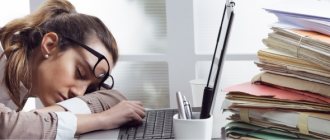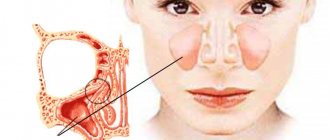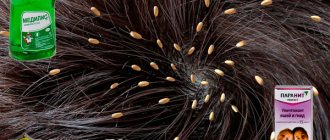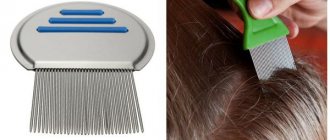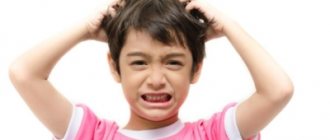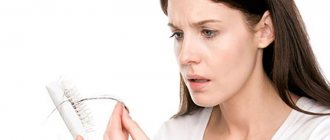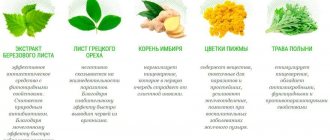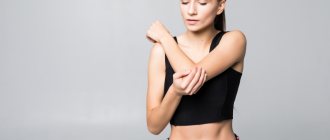Causes
There is an opinion that pediculosis occurs most often in children from disadvantaged families with low social status, where there are no basic conditions for personal hygiene. But this is not true; any child can become infected with head lice. Most often, infection occurs in kindergartens or schools, as well as in holiday camps and in hospital settings for inpatient treatment of children. Lice crawl from a sick child to a healthy one and begin to actively multiply. Females lay eggs called nits, which look like white balls at the base of the hair (about a centimeter from the root of the hair). They can be confused with dandruff, but nits cannot simply be shaken off; they are firmly glued to the hair.
The main routes of transmission of the disease:
- directly from an already infected person or another child;
- infection through other people's combs, hairpins, hats, ribbons;
- when using shared bed linen or towels;
- in public transport through head restraints.
Girls with long, loose hair are more likely to get lice, so it is better to wear their hair in braids.
Examination of a child for pediculosis
What else must be done when removing lice?
Pediculosis is a contagious disease. This means that if lice appear on one of the family members, it is necessary to examine all the others and take preventive measures.
It is better to use any anti-lice products in the bathroom so that the lice removed from the hair do not spread throughout the apartment. During treatment, the person who helps with the application and rinsing of medications, who combs hair and monitors the progress of treatment, must carefully protect themselves. When combing, cover your shoulders and back with a white towel so that you can see the falling insects. The room and everything in it must be washed thoroughly after manipulation. For disinfection, you need to use the same pediculicidal agents, for example, MediLis-Permifen.
Important! Lice and nits can be found not only in the hair, but also in the patient’s personal belongings. All clothing, bed linen, and towels should be washed at high temperatures. You can use a pediculicide solution for soaking. Things that cannot be washed can be treated with a steam cleaner, ironed or exposed to frost - at very high or low temperatures the pests die. It is also better to treat upholstered furniture, mattresses, blankets and pillows with a steam generator or dry cleaning. Head lice do not live in furniture, but they can wait out “difficult times” in it and then continue to parasitize people.
For difficult-to-handle items that cannot be dry cleaned, washed or ironed, you can use this method. Pack them as tightly as possible in a thick plastic bag and leave them in this form for 2 – 4 weeks. During this time, all adults and even nits will die of hunger and will not produce offspring. This method is suitable, for example, for outerwear.
It is also better to rinse the entire apartment with a solution of anti-lice or insecticide. In case of severe damage, you can call special services. The main thing is that the fight must be comprehensive so that not a single individual or egg remains viable. This is the only way to remove these parasites.
Symptoms of childhood lice
Pediculosis is not difficult to recognize. The main symptoms of infection appear in children as follows:
- severe itching of the head appears as a result of lice bites. The child often scratches his head, especially hard behind the ears, where the skin is thinnest;
- red bite marks are visible under the hair, the skin is inflamed and irritated;
- You can see nits on the hair. One adult female louse lays about 10 eggs per day;
- in advanced forms of the disease, the lymph nodes behind the ears become inflamed.
Main signs of pediculosis
The main signs of the disease are:
- 1. Itching. Occurs predominantly in the occipital region. It is noteworthy that itching is present in only 14-36% of infected people.
- 2. Insomnia. Lice feed at night, so the itching can intensify at this time, disturbing sleep.
- 3. Redness and sores. Most often appear on the back of the head and in the neck area.
- 4. Adult lice. They are not easy to see, as the insects move quickly along the hair, hiding from the light.
- 5. Nits. These are lice eggs. They are tiny, light brown in color, and oval in shape. Adults attach them to the hair closer to the scalp. Nits cannot be removed with a regular hair comb.
Treatment of pediculosis in children
Nowadays, pharmacies sell many different effective remedies for head lice for children in the form of shampoos, lotions or sprays.
So how to treat pediculosis in children? The main thing is that the treatment must be combined; it is necessary to destroy not only adult insects, but also their eggs. You can choose the tool that is most convenient for use. The main active ingredient against adult lice, which is part of most drugs, is permethrin. These are new generation drugs that are toxic to insects and harmless to humans. To achieve the desired result, you must strictly follow the instructions and pay attention to the age at which you are allowed to use this or that product.
After treating the head with medications, it is necessary to comb out all nits from the hair using a fine comb, since the poison does not affect them. To facilitate this process, it is recommended to moisten the comb in a heated solution of acetic acid. To prevent relapse of head lice, you should be patient and try to remove all nits the first time.
Traditional medicine offers its own recipes for the treatment of pediculosis in children . It is recommended to treat the scalp with kerosene, vinegar, tar soap, and cranberry juice. Any of the listed products is applied to the scalp and hair for 40 minutes, covered with plastic wrap, and then washed thoroughly.
Methods for getting rid of lice and nits
The fastest way to get rid of lice
The fastest way, which is not suitable for everyone, is to shave your head. Head lice move only on hair, and they also lay eggs only on hair. If there is no hair, then there are no lice. This method is the most effective. The head needs to be shaved, and then, to be on the safe side, you can wash it with anti-pediculosis shampoo to remove any remaining insects and nits that might remain between the skin scales. One such treatment is enough to get rid of lice forever. Care must be taken when processing. The cut hair must be carefully removed, and the room in which the shaving was done must be washed with insecticidal agents so that there are no living parasites and nits left in it. Lice live outside the human body for up to two days, and nits in a state of suspended animation for up to 10 days, after which, once in a favorable environment, they will live and develop further. To prevent this from happening, it is worth taking measures.
Folk remedies
Those with long hair will most likely not agree to get rid of it in order to cure lice. Traditional methods can also be used to remove lice and nits. Most often, folk remedies are used to remove lice from a child. It is believed that such time-tested methods are the most effective and safe.
Mechanical methods
To eliminate the use of any drugs altogether, you can use a comb. It is better to take a special comb with very fine teeth. Before treatment, be sure to cover your shoulders with a towel.
Methodology:
- Wash your hair with regular shampoo and treat only wet hair;
- secure them to the top of the head, separating them from the bun for processing one strand at a time;
- comb thoroughly along the entire length, starting from the very roots;
- after each combing, rinse the comb thoroughly under running water, washing away the adults and nits remaining on it;
- The combed strands are secured in a second, “clean” bun.
This method is suitable for people with not very long and not too thick hair and a slight lice infestation. The difficulty is that you can miss parasites. And if you leave at least one louse or nit in your hair, then in a week they will breed again. The procedure will have to be repeated several times to completely eliminate the presence of nits and adult individuals in the hair.
Kerosene
Attention! This method is considered proven, but it can cause a severe allergic reaction or burn. You need to act very carefully.
There is no need to apply pure kerosene to your hair. In order for it to linger on the head for effect, you need to prepare a mixture of a tablespoon of kerosene, two teaspoons of vegetable oil and a teaspoon of shampoo. For long and thick hair, double the amount of ingredients.
Apply this mixture to dry hair so that it saturates the hair to the roots. Put a plastic cap on the treated hair and wrap your head with a towel. The time required for exposure is 2 hours. For children, exposure time should not exceed 1 hour. After treatment, wash your hair with regular shampoo and rinse with a weak solution of vinegar. After washing, be sure to comb your still damp hair with a fine-tooth comb. After three days, this procedure must be repeated.
The disadvantage of this method, in addition to toxicity, is that in low concentrations kerosene may not kill nits, since they have a very dense shell. But in strong concentration it is dangerous to use it, and it is absolutely forbidden to treat children.
Vinegar
Please note! Vinegar rinsing is useless against adults. But it dissolves the substance with which nits are attached to the base of the hair. Therefore, a vinegar solution is supplemented with kerosene treatment.
The vinegar concentration should not exceed 9%. This is important to ensure safety and avoid burns. To rinse, part vinegar is dissolved in two parts water. For the best effect, the solution is applied to the hair, the head is wrapped in polyethylene and a towel, the mask is left on the hair for half an hour to an hour, after which the hair is thoroughly combed and washed off with shampoo. You can repeat the procedure for several days in a row, but you should not get carried away, as vinegar can change the color and structure of the hair and cause irritation of the scalp.
Herbs and other natural remedies
At home you can use the following products:
- hellebore water - suitable for treating thin and short hair, can be used to treat children, but it is important that there are no wounds on the skin, otherwise it will corrode them and cause an allergic reaction;
- washing your hair with regular shampoo, but with the addition of lavender, tea tree, eucalyptus oil, etc. - the use of essential oils with a pungent odor does not kill insects, but plays more of a preventive role, repelling them;
- rinsing with herbal decoctions (mint, wormwood, wild rosemary) or rubbing a paste of these herbs into the roots of the hair has a weak effect and can help with minor damage;
- a mask of crushed garlic or onion - use this method with caution, as irritation may occur on the scalp;
- wrap of cranberry juice or mint cranberries - in an acidic environment, insects can die, and their eggs will be better peeled off from the hair.
An unexpected and not very natural product that can be mentioned here is hair dye containing ammonia. If you dye her hair, the parasites will die. But it is worth remembering that not all modern paints contain ammonia.
All home remedies have one drawback - they will not help if the infection is severe. Considering the fact that lice removal begins when there are already dozens of them in the head, and there are already hundreds of nits on the roots of the hair, then using folk remedies is pointless. Moreover, if you waste time on them, you can trigger the disease. During this time, the parasite population can only increase. It is better to immediately switch to professional drugs.
Pediculicides
These are professional preparations designed to remove lice. You can also use insecticides - products with a wider spectrum of action that kill all insects, not just lice.
Their active ingredients are different:
- fenthion;
- permethrin;
- malathion;
- eugenol
They are contained in preparations in different concentrations. One product may contain two active substances, for example, permethrin and fenthion.
Release forms are also varied:
- emulsions;
- sprays;
- concentrate for dilution with water.
Depending on the degree of infection and the age of the patients, different MediLis products can be used:
- MediLis-Super, MediLis-Permifene and MediLis-Malathion can be used to treat adults;
- MediLis-I is suitable for adults and adolescents over 14 years of age;
- To treat childhood lice, you can take MediLis-Bio; this drug is safe for children over 5 years old.
Absolutely all anti-pediculosis agents must be used in strict accordance with the instructions. Do not exceed recommended exposure time or concentration.
Usually one treatment is enough to completely remove lice. If the damage is severe, re-use may be necessary. It is usually carried out a week after the first one.
Prevention
To prevent head lice in children, the following measures should be taken:
- prohibit wearing other people's hats or hair clips;
- teach your child to maintain personal hygiene;
- explain to him that he should have his own comb.
Preventive examination of children for pediculosis
After a child arrives home from a camp or sanatorium, a preventive examination for pediculosis of his head should be carried out. If lice or nits are found, you should immediately begin removing them and take preventive measures for members of the entire family.
How to remove lice
- • Home remedies. There are many recipes for treating head lice at home. These include: kerosene, vinegar, essential oils, etc. If you choose this treatment method, you must be prepared for the fact that the fight against parasites will take some time.
- • Pharmacy drugs With the development of medicine, a large number of effective anti-pediculosis drugs have appeared. Their only drawback is that lice develop resistance (become resistant) to insecticide-based preparations
- • Mechanical method. Probably the oldest way to fight head lice. It consists of regularly combing adults and removing nits.
How to protect yourself from lice infestation?
The main method of prevention is to avoid close contact with the head of an infected person. This is difficult to explain to a small child. But teenagers need to understand this simple rule, especially since recent head lice outbreaks around the world have been linked to the habit of taking selfies with children's heads touching. You should also teach your child not to use other people's combs, even though the likelihood of lice being transmitted this way is extremely low.
As a preventive measure, you can use essential oils, especially geranium oil, the smell of which repels lice. You can add a few drops of this oil to your shampoo. Girls with long hair can apply a few drops of oil directly to their hair.
Mechanical method - combing
The number one enemy of lice and nits is the fine-tooth comb. It is almost impossible to successfully get rid of lice without this assistant. Studies have shown that mechanical combing is even more effective than pediculicide treatment. First of all, a fine-tooth comb is the easiest way to diagnose lice. Dermatologists say that diagnosing head lice using a comb is four times more effective and twice as fast as direct visual examination.
Treating lice with a comb is not an easy process, but it is very effective if done correctly. Apply a thick conditioner mixed with a pinch of baking soda to your hair. It will make combing easier. Separate your hair into sections and comb out, starting straight from the scalp. After each stroke, clean the comb with a napkin or paper towel. The procedure must be repeated daily for two weeks until the parasites completely disappear.
Is it possible to remove lice in 1 day?
Unfortunately, you can only get rid of lice in 1 day using a very radical method - shaving your head. However, before resorting to it, consider the following points:
- • You cannot bring a child with lice to the hairdresser. And shaving your head yourself can lead to cuts and infection.
- • Shaving can upset the child and mean temporary isolation. Many children are very embarrassed by such a radical hairstyle, as well as the reason why their parents resort to it.
- • For girls, a shaved head remains a social taboo.
- • In order to be sure to get rid of lice, you will need to completely shave your hair. Parasites cling to even the shortest hairs, so cutting with a clipper will not be enough
Mayonnaise
Mayonnaise is an excellent sauce that is found in almost every kitchen. However, few people know that it can be used to treat head lice. The technique is that viscous mayonnaise closes the respiratory channels of parasites, as a result of which they die from suffocation. People who have tried this product recommend using thick, high-fat mayonnaise. It is applied generously to the hair and the head is covered with film. The sauce is left on the hair for half an hour, after which it is washed off with shampoo. Some people recommend leaving mayonnaise on your hair overnight to increase the effectiveness of treatment.
How to quickly remove lice?
The main mistake that parents make when treating lice is the incorrect use of pharmaceutical products. When treating, be sure to take into account the life cycle of parasites. Most pediculicides do not penetrate the well-protected shell of nits, so treatment must be repeated after 7-10 days, when nymphs hatch from the nits.
Many parents, desperate to cope with lice, spend a lot of effort cleaning the house, suspecting that the child is re-infected with lice through household items. Meanwhile, parasitologists say the fight should be focused on the baby's head, not the environment
A 2010 study published in the journal Open Dermatology found that the risk of transmission from combs, hats and toys is very low. Scientists tested students who had a total of more than 5,500 head lice. However, no parasites were found on their hats. The same goes for floors: When researchers checked the floors of 118 classrooms in a school with a head lice outbreak, no lice were found on them.
Effective method
Currently, there are many pharmaceutical preparations for lice. However, not everything is so simple with them. Although pediculicides have been approved for use by regulatory authorities and are approved by many pediatricians, there are studies that show they are unsafe. Scientists have found a link between the effects of pyrethrins and pyrethroids and increased levels of estrogen (which can increase the risk of cancer), as well as hyperactivity and other behavioral problems in children.
In addition, insecticidal shampoos often do not work because lice develop resistance to them. As an alternative, you can use the anti-pediculosis drug “Paranite”, which has a completely different principle of action. The dimethicone and mineral oil it contains irreversibly block the respiratory tract of lice, leading to their death. Therefore, the drug does not lose its effectiveness even with repeated use. “Paranit” is a low-hazard compound, so it can be used to treat all family members, including children over 1 year old and pregnant women.
To achieve the effectiveness of treatment with “Paranite”, the drug must be applied generously to each strand of hair, starting from the roots to the very ends. The kit includes a fine-tooth comb, which is very effective both in diagnosing head lice and in combing out lice and nits. The new generation product “Paranit” helps to quickly and safely cope with head lice.
Kerosene
This remedy has been used for a long time and, indeed, has a pronounced anti-pediculosis effect. Kerosene is mixed with vegetable oil in a ratio of 1:10. For this purpose, you can use olive, sunflower or corn oil. The resulting mixture is evenly applied to the hair using a cotton swab, the head is covered with film and the product is left for 15 minutes. Before removing lice from a child using this method, keep in mind that kerosene is a toxic and flammable substance. Therefore, this recipe cannot be called safe.
Vinegar
The main disadvantage of this method is that vinegar does not kill adult lice. It simply lacks the properties to do this. However, the acid in vinegar can kill nymphs, young fish that are not yet able to lay eggs. Therefore, the anti-pediculosis effectiveness of vinegar is a controversial issue. However, vinegar does help in the fight against nits. Acetic acid does not dissolve the exoskeleton (the protective shell of nits), and therefore does not kill them. However, it weakens the glue that holds nits on the hair shaft and makes them easier to remove mechanically. To treat with 9% vinegar, it must be mixed with water in a ratio of 1:2, applied to hair, covered with film and left for 30 minutes.

